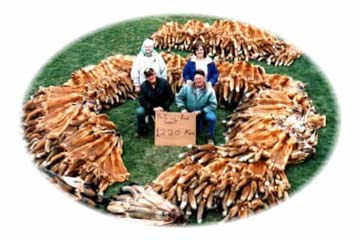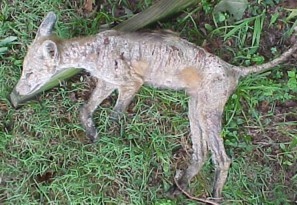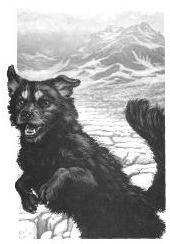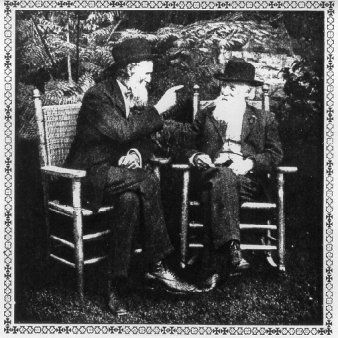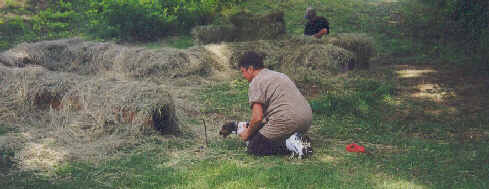For all practical purposes, the story of American terrier work begins in 1971 with Patricia Adams Lent, who founded the American Working Terrier Association to promote working terriers and dachshunds.
The American Working Terrier Association (AWTA) was, and is, a modest organization with fewer than 100 members. It has no headquarters or paid staff, and produces a simple Xeroxed newsletter four times a year. Its web site (as of 2005) has no information about actual hunting or wildlife, and is focused almost entirely on go-to-ground trials.
That said, AWTA is a very important organization in the history of American working terriers, not only because it was the first "club" devoted to the sport, but also because Ms. Lent invented go-to-ground trials, and the basic set of rules governing them.
Since 1971, go-to-ground trials have served as a kind of "on ramp" for actual field work. The basic
AWTA format has been widely copied, first by the Jack Russell Terrier Club of America (1976) and then by the American Kennel Club (1994).
The origin of the American go-to-ground tunnel can be found in the artificial fox earths first constructed in the UK in the 1920s, but which came into their own in the 1950s and 60s with the collapse of so many ancient rabbit warrens under the onslaught of myxomatosis.
Artificial earths are generally constructed of two parallel rows of brick stacked three bricks high and topped by overlapping slates, or out of 9-inch clay or concrete drainage pipe laid end-to-end. The result is a very spacious and dry fox earth. If sited within 200 feet of a water source (it does not have to be large), far from residences, and on the edge of fields and small woods, the chance of a fox taking up residence is excellent.
The first artificial fox earths were constructed in order to guarantee that a fox could be found on hunt day, and to encourage fox to run along known courses away from roadways. That said, they also found favor because they proved easy locations for a terrier to bolt a fox from. Even an overlarge dog could negotiate the straight or gently curving unobstructed nine-inch pipes of an artificial earth.
The go-to-ground tunnels devised by Patricia Adams Lent were constructed of wood instead of stone, brick or clay pipe, but were equally commodious, measuring 9 inches on each side with a bare dirt floor for drainage and traction.
From the beginning AWTA's goal was to be inclusive. Scottish Terriers with enormous chests were encouraged to join
AWTA, as were owners of West Highland Whites, Cairns,
Norfolks,
Norwiches, Border Terriers, Fox Terriers,
Lakelands, Welsh Terriers and
Bedlingtons. All were welcome, with the simple goal of having a little fun with the dogs, and perhaps giving American Kennel Club terrier owners some small idea of what actual terrier work was about.
In AWTA trials, wooden den "liners" are sunk into a trench in the ground. The tunnels are up to 35 feet long with a series of right-angle turns, false dens and exits. The “quarry” at the end of the tunnel is a pair of "feeder" lab rats safely protected behind wooden bars and wire mesh. The rats are not only not harmed, but after 100 years of breeding for docility, some lab rats have been know to go to sleep!
Without a doubt, go-to-ground trials have been a huge hit with American terrier owners. The
interior dimensions of the den liners -- 81 inches square -- means even over-large terriers are able to negotiate them with ease. With nothing but a caged rat to face as "quarry," the safety of dogs is guaranteed, and since the dogs only have to bay or dig at the quarry for 90-seconds, most dogs end up qualifying for at least an entry-level certificate or ribbon.
Though the die-hard hunter may sneer, the increasing popularity of go-to-ground terrier trials is a welcome thing, for it has brought more people a little closer to real terrier work.
Owners of dogs that do well in go-to-ground trials should take pride in their dog’s achievements. Like all sports that emulate real work (lumber jack contests, bird dog trials, and sheep dog trials, to name a few), a go-to-ground trial is both harder and easier than its real-world cousin.
A dog that will exit a 30-foot tunnel backwards in just 90 seconds and on a single command (a requirement for earning an
AKC Senior
Earthdog certificate) is a dog that has been trained to a fairly high degree of proficiency.
Having said that, it should be stressed that a go-to-ground trial has little relationship to true hunting. In the field dogs are not rewarded for speed. In fact, if a hunt terrier were to charge down a real earth like it were a go-to-ground tunnel it would quickly run into quarry capable of inflicting real damage.
In addition, in a real hunting situation a dog must do a great deal more than “work” the quarry for 90 seconds. A good working dog will stick to the task for as long as it can hear people moving about overhead – whether that is 15 minutes or three hours.
The real division street between go-to-ground and earthwork, however, is size. And the real problem with a go-to-ground trial is not that it teaches a dog to go too fast down a tunnel (dogs understand the difference between fake liners and real earth), but that it suggests to terrier owners that any dog that can go down a cavernous go-to-ground tunnel is a dog “suitable for work.”
To its credit, the American Working Terrier Association recognizes the difference between a go-to-ground tunnel and real earth work, and implicitly underscores this difference in its rules for earning a Working Certificate.
AWTA rules note that a terrier or dachshund can earn a working certificate on woodchuck, fox, raccoon, badger, or an “aggressive possum” found in a natural earth, but that “this does not include work in a drain or otherwise man-made earth.”
In short, a drain is not a close proxy for a natural earth, and terriers that are too large to work a natural earth do not meet the requirements of a working terrier.
The American Working Terrier Association issues Certificates of Gameness to dogs qualifying at their artificial den trials. Working Certificates are awarded to dogs that work groundhog, fox, raccoon, possum, or badger in a natural den provided that at least one
AWTA member is there as a witness.
AWTA also issues a Hunting Certificate to a dog that hunts regularly over a period of a year.
Six years after the American Working Terrier Association was created, Mrs.
Alisia Crawford, one of the first Jack Russell Terrier breeders in the U.S., founded the Jack Russell Terrier Club of America (
JRTCA)
Ms. Crawford and the early founders of the Jack Russell Terrier Club put a lot of thought into structuring the JRTCA so that work remained front and center. Towards that end, the club decided that its highest award -- the "bronze medallion" -- would not go to show dogs, but to working dogs that had demonstrated their ability in the field by working at least three of six types of American quarry -- red fox, Gray fox, raccoon, groundhog, possum, and badger -- in front of a
JRTCA-certified field judge.
In the show ring the JRTCA decided to ban professional handlers as it was thought this would keep the shows fun and less important than the essential element of work.
Instead of mandating the kind of narrow conformation ranges demanded by the Kennel Club for their terrier breeds, the
JRTCA divided the diverse world of the Jack Russell Terrier into three coat types (smooth, broken and rough), and two sizes (10 inches tall to 12.5 inches tall, and 12.5 inches tall to 15 inches tall).
"Different horses for different courses" became a watch word, with overt recognition that the world of working terriers required dogs able to work different quarry in different earths, and in different climates.
Unlike the Kennel Club the JRTCA also decided to keep their registry an "open" registry so that new blood might be infused at times. At the same time, the Club discouraged inbreeding and eventually restricted line breeding to a set percentage.
To balance off an open-registry with the desire to keep Jack Russell-type dogs looking like Jack Russells, the
JRTCA decided not to allow dogs to be registered at birth or to register entire litters. Instead, each dog would be photographed from each side and the front, and admitted to the registry on their own merit, and as an adult. In addition, each dog had to be measured for height and chest span.
What this meant is that at the time of registration, the height and chest measurement of an adult dog could be recorded. Over time, both height and chest size could be tracked through pedigrees -- an essential element of breeding correctly-sized working terriers.
The JRTCA was not shy about their rationale for these rules: they openly and emphatically opposed Kennel Club registration, maintaining that time had show that dogs brought into the Kennel Club quickly grew too big and often lost other essential working attributes such as nose, voice, and prey drive.
Today the Jack Russell Terrier Club of America is the largest Jack Russell Terrier club and registry in the world, and its Annual National Trial attracts approximately 1,200 Jack Russell terriers from all over the U.S. and Canada.
The JRTCA's small professional staff cranks out a solid bi-monthly magazine that is 80-100 pages long, holds a regular schedule of dog shows, and sells
deben locator collars, fox nets, and a host of other items ranging from hats and jackets to coffee cups.
The web site of the Jack Russell Terrier Club of America (
http://www.terrier.com/ is one of the very best dog sites in the United States, packed with well-presented information, high-quality graphics and a user-friendly layout.
Perhaps the most important service work of the JRTCA are the ads that the Club routinely runs in all-breed publications warning people that Jack Russell Terriers are not a dog for everyone, are primarily a hunting dog, and are not like the cute dogs seen on TV.
Sometime in the last 1990s, following the appearance of Jack Russell Terriers in a host of TV and Hollywood productions ranging from "Wishbone" and "Frasier" to "My Dog Skip" and "The Mask," the American Kennel Club decided to add the Jack Russell Terrier to its roles.
As they had previously done with the Border Collie, the AKC ignored the strong opposition of the large existing breed club, and quietly assembled a new club of show-ring breeders to serve as their stalking horse.
The "Jack Russell Terrier Breeders Association" (later called the Jack Russell Terrier Association of America, and now called the "Parson Russell Terrier Association of America") petitioned for the admission of the Jack Russell Terrier into the Kennel Club and, despite the objections of the
JRTCA, the breed was admitted in January of 2001.
The admission of the Jack Russell Terrier into the American Kennel Club was a contentious affair, with the
JRTCA standing firm on its long-held rule that no dog could be dual-registered.
What this meant is that breeders had to chose whether to remain in the JRTCA or to "get in early" with the
AKC before they closed their registry.
Some of the breeders that chose the AKC did so because they thought they could then sell their puppies for more money, others were eager to be the "big fish in a small pond" at the beginning of a new
AKC breed registry. Still others were anxious to attend more dog shows,.
Whatever the reason, the Kennel Club required that the Jack Russell Terrier breed description be narrower than that of the JRTCA. The goal of a Kennel Club breed description is to craft a narrow "standard" -- the wide variance in size, coat and look allowed and encouraged in the world of working terriers would not do.
The American Kennel Club breed standard stipulated that an
AKC Jack Russell terrier could not be under 12 inches in height nor over 15 inches in height, and further stipulated that "ideal" dog was 14 inches tall and the ideal bitch was 13" tall.
Ironically, this breed description effectively eliminated about 40% of all the American dogs that had actually worked red fox in the U.S.
More importantly, this narrow standard eliminated the small dogs necessary to "size down" a breed -- something absolutely necessary in order to keep working terriers small enough to work.
Of course the American Kennel Club has never been interested in working terriers and the breed club they created has shown no interest in work either.
Under continuing pressure from the working Jack Russell Terrier community in England and the U.S., the British and American Kennel Clubs decided to jettison the "Jack Russell Terrier" name to more easily identify the non-working show ring dog they favored.
Now called the "Parson Russell Terrier," the AKC dog is quickly getting too big in the chest to work -- though not many dogs are actually taken out into the field to try.
After just three years in the Kennel Club, the "Parson Russell Terrier Club" tried to modify the show ring standard so that the dog no longer had to be spanned. In fact, many Kennel Club judges do not know how to span a terrier and many do not do it as a consequence.
In 2001, the United Kennel Club started an "earth work" program modeled after that of the Jack Russell Terrier Club of America. The
UKC working terrier program remains small, with relatively few judges, and it does not appear to be growing very rapidly.








